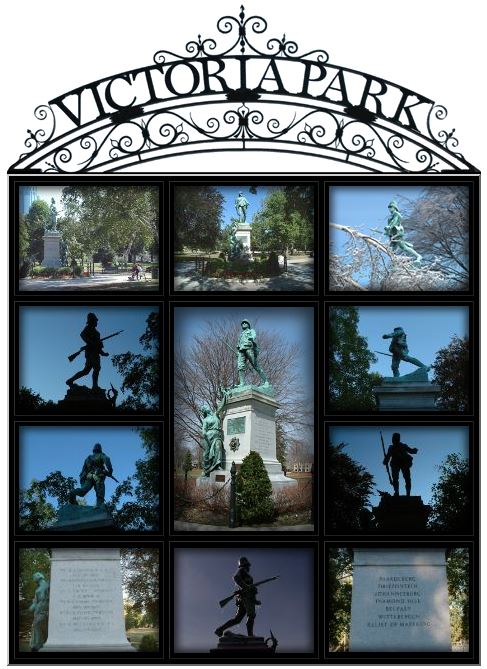[VPC-SALE]By John M. Milner
In 1899, a battalion of volunteers left Canada, heading for the conflict in South Africa that would pit the British Empire against two small republics (Transvaal and Orange Free State) that had been settled by Dutch settlers and were now populated by Boers, descendants of those settlers.
The South African or Second Boer War as it was known, lasted from 1899-1902 and involved more than 7000 Canadians, including 12 female nurses. Some 2000 other troops served as garrison troops in Halifax, Nova Scotia, to allow British troops to serve at the front, or landed after the fighting ended. The conflict marked the second time
Canada’s involvement in the Boer War was a source of much controversy for Prime Minister, Sir Wilfred Laurier. Many English-Canadians urged the Canadian government to help, and the press was filled with pro-British and anti-Boer articles in the months before the October 11th 1899 declaration of war.
On the other hand, many French-Canadians, English-Canadian labour organizations and farmers’ groups, as well as recent immigrants from non-British countries, questioned the sense of sending troops to a war halfway around the world. Henri Bourassa, who led opposition to Canada’s involvement, believed that Canadian involvement in the Boer War would set a dangerous precedent. At one point, a three-day riot broke out in Montreal.
Finally, Laurier agreed to a compromise and sent a battalion of volunteers to South Africa. While Canada would pay for the recruitment and transportation of that battalion to the conflict, upon its arrival, it would become Great Britain’s financial responsibility.
The unit in question was the Second (Special Service) Battalion of the Royal Canadian Regiment of Infantry (2 RCRI), led by Lieutenant-Colonel William Dillon Otter, who was “the country’s most experience professional soldier”, which arrived in South Africa on November 29, 1899.
The battalion consisted of eight 125-man companies, each raised in a different region. One was from West, three from Ontario and two each from Quebec and the Maritimes. Despite their inexperience, the Battalion would battle the Boers at Paardeberg less than three months after they arrived.

At the time of the battle at Paardeberg, the Boer War had just ended what historians had labelled the first phase of the war, which lasted from October 1899 to January 1900 and saw the Boers advance into British territories. The British tactics saw their troops charge into the Boer positions, and suffered horrific casualties.
By February 1900, the British had launched a counter-offensive that would see them advance through Orange Free State and capture Pretoria. On February 18th, 866 men and 31 officers of the 2 RCRI were part of a British force, some 30 000 strong that battled a Boer contingent under Piet Cronje who had been fleeing eastward when they were forced into a defensive position by British cavalry.
The Canadians suffered their first casualties during that battle, including 18 dead and 63 wounded, participating in an unsuccessful charge, ordered by the acting British commander, Lord Herbert Kitchener.
The Boers continued to hold on but were soon on the verge of defeat. Lord Frederick Roberts, the British commander-in-chief, ordered the Canadians forward, on the evening of February 26-27 for what he hoped would be the final assault. However, as the Canadians advanced, someone struck a trip wire and the Boers began to fire back. Most of the Canadians began to retreat, save two companies who remained and continued to fire into the Boer positions. Later that morning, the Boers surrendered, making this the first Boer defeat of the war. . It was known as Bloody Sunday, where the British and Canadians suffered the highest casualties of the war.
Canadian troops were in action at Wwpwnwe (April 9-25, 1900), Doorkop (May 29, 1900), Johannesberg (May 31, 1900), Diamond Hill (June 11-12, 1900), Belfast, August 26. 1900) and Komati River (November 6-7, 1900).
Although defeated in several key battles, the Boers adapted guerrilla warfare tactics, inflicting heavy casualties through ambushes. Imperial troops, meanwhile, began to burn Boer houses, and moved civilians into internment counts, where thousands would perish from disease.
On November 6th, 1900, a Canadian force that included the Canadian Mounted Rifles, the Royal Canadian Dragoons, and one section of “D” Battery, Royal Canadian Field Artillery, with two 12-pounder guns, accompanied a strong British column that pressed Boer Commandos back across Komati River. That night, encamped at Leliefontein, the British commander decided to withdraw, leaving the under-strength Dragoons (who numbered no more than one hundred and a horse drawn Colt machine gun) and two field guns behind. The Boers, realizing that the enemy was withdrawing pressed the Canadian rearguard, including a mounted charge by 200 Boers. The mounted charge nearly broke the Canadian line, only to be beaten back by the Dragoons and the machine gun. After two Boer commanders were killed, the Boer troops lost momentum.
Three Victoria Crosses (of four to be awarded to Canadians during the war), to Lieutenants H.Z. C. Cockburn, R.E.W. Turner and Sergeant E.J. Holland, all of the Royal Canadian Dragoons, were awarded to Canadians as a result of the fighting at Komati River.
In the end, the British would defeat the Boers, with the war ending on May 31, 1902.
In the three years of battle, 267 -277- 284, Canadians were killed or died of disease and another 252 wound.

 A Lucky Black Squirrel (Lottery Charm®) pin was used to hold the winning grand prize ticket for the lottery (previously known as Dream Of A Lifetime Lottery) on a corkboard in the office of LotteryCharms.com® creator Ric Wallace.
A Lucky Black Squirrel (Lottery Charm®) pin was used to hold the winning grand prize ticket for the lottery (previously known as Dream Of A Lifetime Lottery) on a corkboard in the office of LotteryCharms.com® creator Ric Wallace.
* * * SHOP ONLINE * * *
LUCKY PINS | LUCKY COINS | LOTTO BOOKS | MAGNETS

Some Boer War Web Sites
- Canadian Participation in the South African War
- Canadians in the South Africa (Boer) War 1899 to 1902
- With The Royal Canadians, by Stanley McKeown Brown (1900)
- The Boer War
- Perspectives: the South African War from Original and Contemporary Sources
- The Anglo-Boer Wars by Battlefields.co.za
- Anglo-Boer War Centenary, by Dup Martins
- Long Tom’s War Zone, by Herman Labuschagne

 A Lucky Black Squirrel (Lottery Charm®) pin was used to hold the winning grand prize ticket for the lottery (previously known as Dream Of A Lifetime Lottery) on a corkboard in the office of LotteryCharms.com® creator Ric Wallace.
A Lucky Black Squirrel (Lottery Charm®) pin was used to hold the winning grand prize ticket for the lottery (previously known as Dream Of A Lifetime Lottery) on a corkboard in the office of LotteryCharms.com® creator Ric Wallace.
* * * SHOP ONLINE * * *
LUCKY PINS | LUCKY COINS | LOTTO BOOKS | MAGNETS





![can-wave[1]](https://www.victoria-park.com/wp-content/uploads/2014/08/can-wave1.gif)

![MP3-ADVERT_r2_c1_f2[1]](https://www.victoria-park.com/wp-content/uploads/2014/08/MP3-ADVERT_r2_c1_f21.gif)


